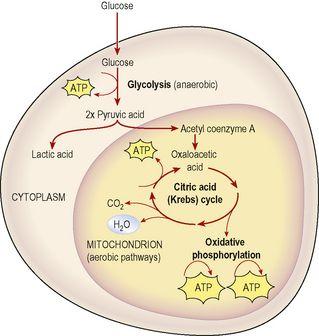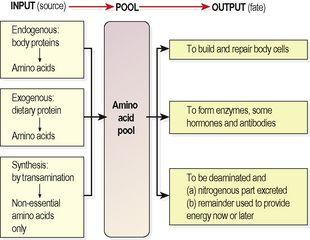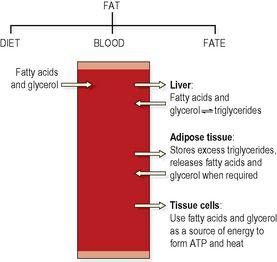Ross & Wilson Anatomy and Physiology in Health and Illness (145 page)
Read Ross & Wilson Anatomy and Physiology in Health and Illness Online
Authors: Anne Waugh,Allison Grant
Tags: #Medical, #Nursing, #General, #Anatomy

•
Carbohydrate in excess of that required to maintain the blood glucose level and glycogen stores in the tissues is converted to fat and stored in the fat depots.
All body cells require energy to carry out their metabolic processes including multiplication for replacement of worn out cells, contraction of muscle fibres and synthesis of secretions produced by glands. The oxidation of carbohydrate and fat provides most of the energy required by the body. When glycogen stores are low and more glucose is needed, the body can make glucose from non-carbohydrate sources, e.g. amino acids, glycerol. This is called
gluconeogenesis
(formation of new glucose).
Carbohydrate and energy release (
Fig. 12.40
)
Glucose is broken down in the body releasing energy, carbon dioxide and metabolic water. Catabolism of glucose occurs in a series of steps with a little energy being released at each stage. The total number of ATP molecules which may be generated from the complete breakdown of one molecule of glucose is 38, but for this to be achieved the process must occur in the presence of oxygen (aerobically). In the absence of oxygen (anaerobically) this number is greatly reduced; the process is therefore much less efficient.
Figure 12.40
Oxidation of glucose.
Aerobic respiration (catabolism)
Aerobic catabolism of glucose can occur only if the oxygen supply is adequate, and is the process by which energy is released during prolonged, manageable exercise. When exercise levels become very intense, the energy requirements of muscles outstrip the oxygen supply, and anaerobic breakdown then occurs. Such high levels of activity can be sustained for only short periods, because there is accumulation of wastes (mainly lactic acid) and reduced efficiency of the energy production process.
The first stage of glucose catabolism is
glycolysis
. This is an anaerobic process that takes place in the cytoplasm of the cell. Through a number of intermediate steps one glucose molecule is converted to two molecules of pyruvic acid, with the net production of two molecules of ATP. The remainder of the considerable energy stores locked up in the original molecule of glucose is released only if there is enough oxygen to allow the pyruvic acid molecules to enter the biochemical roundabout called the
citric acid cycle
(
Fig. 12.40
). This takes place in the mitochondria of the cell and is oxygen dependent. For every two molecules of pyruvic acid entering the citric acid cycle, a further two molecules of ATP are formed but this is still far short of the maximum possible 38 ATP molecules. The remaining 34 molecules of ATP come from the third energy-generating process,
oxidative phosphorylation
, a process dependent on hydrogen atoms released during earlier stages of glucose breakdown. Oxidative phosphorylation, like the citric acid cycle, can occur only in the presence of oxygen and takes place in the mitochondria.
Anaerobic catabolism
When oxygen levels in the cell are low, the molecule of glucose still undergoes glycolysis and is split into two molecules of pyruvic acid, because glycolysis is an anaerobic process. However, the pyruvic acid does not enter the citric acid cycle or progress to oxidative phosphorylation; instead it is converted anaerobically to lactic acid. Build-up of lactic acid causes the pain and cramps of overexercised muscles. When oxygen levels are restored, lactic acid is reconverted to pyruvic acid, which may then enter the citric acid cycle.
Fate of the end products of carbohydrate metabolism
Lactic acid
Some of the lactic acid produced by anaerobic catabolism of glucose may be oxidised in the cells to carbon dioxide and water but first it must be changed back to pyruvic acid. If complete oxidation does not take place, lactic acid passes to the liver in the circulating blood where it is converted to glucose and may then take any of the pathways open to glucose (
Fig. 12.39
).
Carbon dioxide
This is excreted from the body as a gas by the lungs.
Metabolic water
This is added to the considerable amount of water already present in the body; excess is excreted as urine by the kidneys.
Protein metabolism
Dietary protein consists of a number of amino acids. About 20 amino acids have been named and nine of these are described as
essential
because they cannot be synthesised in the body. The others are
non-essential
amino acids because they can be synthesised by many tissues. The enzymes involved in this process are called
transaminases
. Digestion breaks down dietary protein into its constituent amino acids in preparation for absorption into the blood capillaries of the villi in the wall of the small intestine. Amino acids are transported in the portal circulation to the liver and then into the general circulation, thus making them available to all the cells and tissues of the body. Different cells choose from those available the particular amino acids required for building or repairing their specific type of tissue and for synthesising their secretions, e.g. antibodies, enzymes or hormones.
Amino acids not required for building and repairing body tissues cannot be stored and are broken down in the liver (see deamination below).
Amino acid pool (
Fig. 12.41
)
A small pool of amino acids is maintained within the body. This is the source from which the different cells of the body draw the amino acids they need to synthesise their own materials, e.g. new cells, secretions such as enzymes, hormones and plasma proteins.
Figure 12.41
Sources and use of amino acids in the body.
Sources of amino acids
Exogenous
These are derived from dietary protein.
Endogenous
These are obtained from the breakdown of body proteins. In adults, about 80 to 100 g of protein are broken down and replaced each day. The entire intestinal mucosa is replaced about every 5 days.
Loss of amino acids
Deamination
Amino acids not needed by the body are broken down, or deaminated, mainly in the liver. The nitrogenous part, the amino group (NH
2
), is converted to ammonia (NH
3
) and then combined with carbon dioxide forming
urea
, which is excreted in the urine. The remaining part is used to provide energy, as glucose by gluconeogenesis, or stored as fat, if in excess of immediate requirements.
Excretion
The faeces contain a considerable amount of protein consisting of cells shed from the lining of the alimentary tract.
Endogenous and exogenous amino acids are mixed in the ‘pool’ and the body is said to be in
nitrogen balance
when the rate of removal from the pool is equal to the additions to it. Unlike carbohydrates, the body has no capacity for the storage of amino acids except for this relatively small pool.
Figure 12.42
depicts what happens to amino acids in the body.
Amino acids and energy release (see
Fig. 12.44
)
Proteins, in the form of amino acids, are potential fuel molecules that are used by the body only when other energy sources are low, e.g. in starvation. To supply the amino acids for use as fuel, in extreme situations, the body breaks down muscle, its main protein source. Some amino acids can be converted directly to glucose, which enters glycolysis. Other amino acids are changed to intermediate compounds of the central metabolic pathways, e.g. acetyl coenzyme A or oxaloacetic acid, and therefore enter the system at a later stage.
Fat metabolism (
Fig. 12.43
)
Fat is synthesised from excess dietary carbohydrates and proteins, and stored in the fat depots, i.e. under the skin, in the omentum or around the kidneys.
Figure 12.43
Sources, distribution and use of fats in the body.
Fats that have been digested and absorbed as fatty acids and glycerol into the lacteals are transported via the cisterna chyli and the thoracic duct to the bloodstream and so, by a circuitous route, to the liver. Fatty acids and glycerol circulating in the blood are used by the cells of organs and glands to provide energy and in the synthesis of some of their secretions. In the liver some fatty acids and glycerol are used to provide energy and heat, and some are recombined forming
triglycerides
, the form in which fat is stored. A triglyceride consists of three fatty acids chemically combined with a glycerol molecule (see
Fig. 2.9, p. 24
). When required, triglycerides are converted back to fatty acids and glycerol and used to provide energy. The end products of fat metabolism are energy, heat, carbon dioxide and water.
Fatty acids and energy release
When body tissues are deprived of glucose, as occurs in prolonged fasting, starvation, energy-restricted diets or during strenuous exercise, the body uses alternative energy sources, mainly fat stores. Fatty acids may be converted to acetyl coenzyme A, and enter the energy production pathway in that form. One consequence of this is accumulation of
ketone bodies
, which are produced in the liver from acetyl coenzyme A when levels are too high for processing through the citric acid cycle (see
Fig. 12.44
). Ketone bodies then enter the blood and can be used by other body tissues, including the brain (which is usually glucose dependent) as a source of fuel. However, at high concentrations, ketone bodies are toxic, particularly to the brain. Ketone bodies include acetone and some weak organic acids. Normally levels are low because they are used as soon as they are produced. When production exceeds use, in the situations mentioned above, levels rise causing
ketosis
. Ketosis is associated with acidosis, which can lead to coma or even death if severe. Excretion of excess ketone bodies is via:



